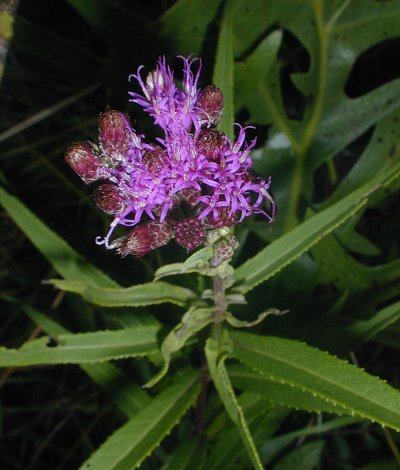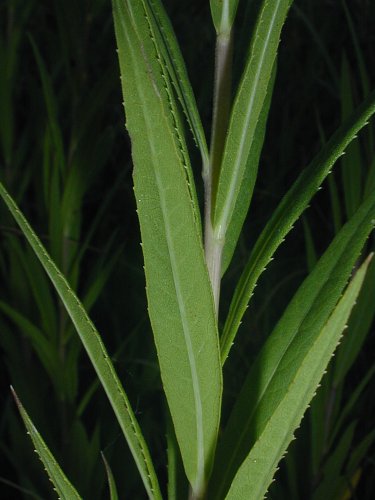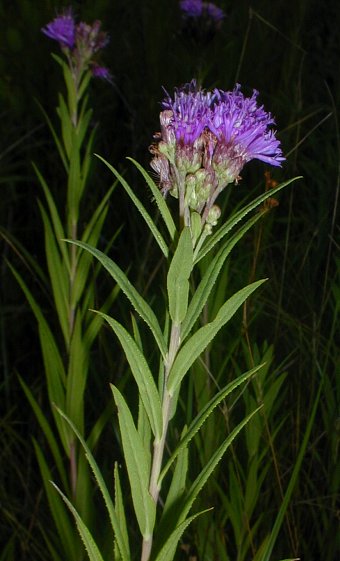Description: This herbaceous perennial plant is 2-4' tall and unbranched. The central stem is round, hairless, and white, light green, or reddish purple. The alternate leaves are up to 5" long and ½" across. They are narrowly lanceolate, narrowly ovate, or linear. Their margins are serrated, while the upper and lower leaf surfaces are hairless. The lower leaf surface also has a prominent central vein, and black dots may be present. The leaves are sessile against the stem, or they have short petioles. The central stem terminates in a flat-topped cluster of magenta compound flowers (i.e., a corymb). This flower cluster is quite dense, rather than loose and spreading. The flowering stalks may be slightly pubescent.

A compound flower
consists of 15-30 disk florets with a short cylinder of green bracts
underneath. These bracts are appressed together like fish scales, and
they are often slightly ciliate. The cylinder of bracts spans about
1/5" across. A disk floret is magenta, with 5 spreading lobes and a
prominent divided style. The blooming period occurs from late summer to
early fall, and lasts about a month. There is no noticeable floral
scent. The flowers are replaced by achenes that have a pappus of
hair-like scales. These achenes can be blown several feet from the
mother plant by gusts of wind. The root system is spreading and fibrous.
Cultivation:
The preference is full sun, moist conditions, and fertile soil. Partial
sun and slightly moister or drier conditions are also tolerated. This
plant can withstand occasional flooding for short periods of time. The
foliage is not bothered by pests and disease to any significant extent.

Range &
Habitat:
The native Smooth Ironweed is fairly common in in the northern half of
Illinois,
but uncommon elsewhere in the state (see Distribution
Map). Habitats include wet to moist black soil prairies,
riverbottom prairies, marshes, sloughs along railroads, and edges of
fields. Smooth Ironweed is found in wetland habitats to a greater
extent than other species of Ironweeds.
Faunal Associations:
The flowers attract long-tongued bees, butterflies, and skippers
primarily. Other visitors include bee flies and Halictid bees. These
insects seek nectar, although bees also collect pollen. Among the
long-tongued bees, are such visitors as bumblebees, Epeoline cuckoo
bees, Miner bees, and large Leaf-Cutting bees. An oligolectic bee of
Ironweeds is Melissodes vernoniae. The caterpillars
of several moths feed on Ironweed, including Grammia
parthenice (Parthenice Tiger Moth) and Perigea
xanthioides (Red Groundling). Caterpillars that bore into the
roots or stems of Ironweed include Papaipema cerussata
(Ironweed Borer Moth), Carmenta bassiformis
(Eupatorium Borer Moth), and some Polygrammodes spp.
(Pyralid Moths). The bitter foliage of Ironweed deters consumption by
mamamalian herbivores – it is known as an 'increaser' because it is one
of the last plants to be eaten in overgrazed pastures.

Photographic
Location:
The photographs were taken of plants growing in a moist prairie along a
railroad in Iroquois County, Illinois.
Comments:
Another common name for this plant is Common Ironweed. However, in
southern Illinois, this species is not common. Smooth Ironweed is one
of the smaller Ironweeds with a compact inflorescence and smooth
hairless leaves. Other Ironweed species have hairy stems or leaves. An
exception is Vernonia gigantea (Tall Ironweed),
which has hairless leaves and stems upon occasion. However, Tall
Ironweed has a spreading inflorescence, and it is usually a taller
plant (as the name implies). The larger leaves of Tall Ironweed exceed
½" across, while the leaves of Smooth Ironweed are ½" or less. Some
authorities state that Smooth Ironweed has black dots on the undersides
of the leaves, but this is not always true. The species in this genus
are occasionally difficult to identify because they can hybridize with
each other.